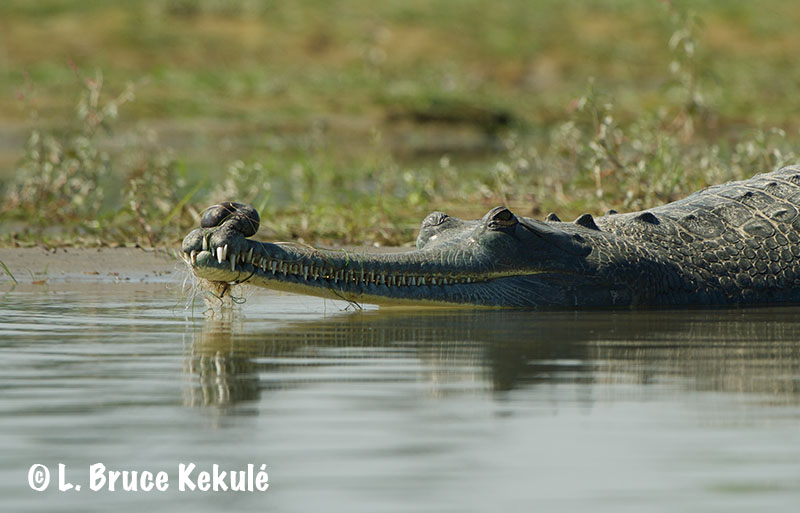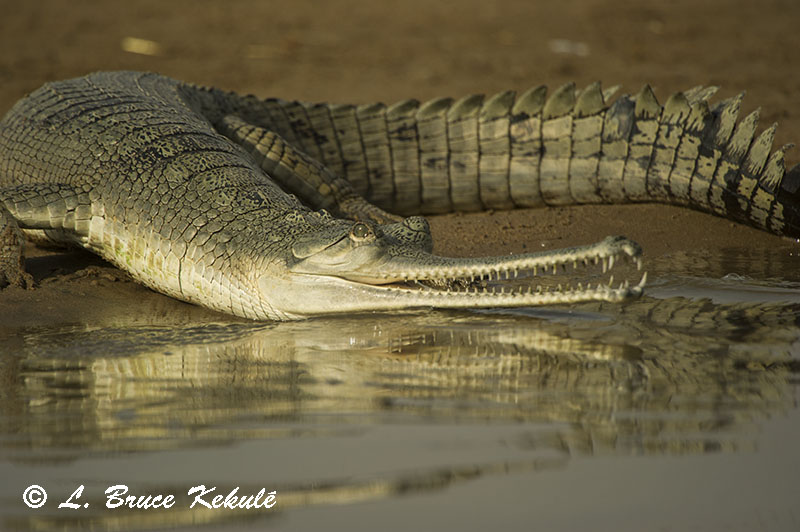Posts Tagged ‘mugger crocodile’
The Plight of the Indian Gharial
A rare crocodilian under threat
A male gharial with fishnet wrapped around it’s snout…!
I have just returned from a crocodile sanctuary in Northeast India where the common mugger and the rare gharial are found in fair numbers. The Katarniaghat Wildlife Sanctuary covers an area of 400 square kilometers and was established in 1975. The protected area is in the Upper Gangetic plain situated in Uttar Pradesh State in Northeast India
A close-up of the male gharial with fishnet…!
The Katerniaghat Forest provides strategic connectivity between tiger habitats of Dudhwa and Kishanpur in India and the Bardia National Park in Nepal. Its fragile Terai ecosystem comprises a mosaic of sal and teak forests, lush grasslands, numerous swamps and wetlands. It is home to a number of endangered species including the gharial, tiger, rhino, Gangetic dolphin, swamp deer, hispid hare, Bengal florican, the white-backed and long-billed vultures.
A female gharial with fishnet…red-whistling ducks in the back…!
One of the best places in the world for seeing the gharial in its natural habitat is the Girwa River, where it is found sympatric with the mugger crocodile. The population of gharials in this stretch was one of the three that were still breeding, when the project to conserve this reptile from the verge of extinction was initiated in 1975. However, between the years of 2001 and 2005, almost all the gharial nests were raided by tribals who consider them a delicacy.
Another female gharial with fishnet…!
The sanctuary is under the Indian Forest Department’s responsibility, and breeding of the gharial is being carried out at the station next to the lake. This crocodilian was almost wiped out in India by poachers for the crocodile skin trade but was saved by concerted efforts not to loose this important crocodile species. They are breeding quite well here and have been released into the lake. There are about 200 gharial surviving with programs for future reintroduction.
A young gharial in the breeding center…!
Fishing is strictly prohibited but unfortunately, illegal fishing with nets is being carried out by local and Nepalese fisherman, probably at night when there are no patrolling boats around. I photographed quite a few gharials with fishnets wrapped around their snouts. This is of course is unacceptable and the Forest Department at Katarniaghat needs to abduct any people involved in these activities.
Gharials, mugger and whistling ducks…!
The gharials need to be captured and this nylon net material removed. It is the duty of the FD to see that these creatures live their life in harmony without any harm coming to them.
A trip to Chambal River in Agra, India
Gharial crocodiles and the Sarus crane were the main objective…!
This was to be my last safari on this month long trip to India. The site is situated in Agra, east of Delhi where the famous Taj Mahal is located.
A female gharial regulating her body temperature early in the morning by the Chambal River in Agra…!
The Chambal River has some very interesting creatures and the main ones I was after were the gharial (thin-jawed fish eating crocodile) and the Sarus crane (the world’s tallest bird). Time was limited and I was lucky to photographed both species in one day.
Another female gharial and its tell-tale thin jaw for catching fish; they are an amazing crocodilian…!
I stayed at the Chambal Safari Hotel some 70 kilometers past the city of Agra. We left at 5am and arrived at the boat landing where a speed boat was waiting near dawn that was another 22 kilometers from the lodge.
And yet another female gharial before slipping into the Chambal River…! No males were photographed…!
Within no time at all, we bumped into gharial and I got several but they were all female. The males would slip into the river as soon as they spotted us.
A breeding pair of Sarus cranes feeding and dancing on Chambal; these wonderful birds mate for life…!
But I was happy to get some decent photographs and as the sun rose into the sky, it became dreadfully hot and light was very harsh so we returned to the hotel for lunch.
The Sarus crane is the tallest bird in the world and they are thriving very well in India at several locations….!
Other species captured were the mugger crocodile and Indian blue peafowl in full display mode. Many water birds are also found here.
A Indian peafowl male in full display. These birds thrive by the river and are absolutely beautiful…!
Back again at 3:30pm and we motored up the river once again. Shortly thereafter, two Sarus cranes were spotted feeding along a sandy bank. I was delighted and surprised to see how close we got to the tall birds.
A mugger or marsh crocodile basking in the morning sun. This reptile is estimated to be about 3 meters long…!
I will return in mid-March 2017 when the weather is much cooler and the crocs are a lot easier to see when they need to bask for long periods in the sun regulating their body temperature due to the very cold river. All in all, it was a quick but very satisfying trip to the Chambal River. Enjoy…!
An Apex-Predator straight from the Triassic Era
A Mugger Crocodile in Satpura Tiger Reserve.
A 4-meter mugger basking in the mid-morning sun – 10 minutes before the end of my finale safari…!
After almost 20 days of solid morning and afternoon safaris on hot dusty roads in India’s tiger reserves situated in the State of Madhya Pradesh, I decided to take a boat safari offered by the park authorities on my last safari at Satpura Tiger Reserve. Arriving around 7am at the boat dock, we jumped into a speedboat and then encountered many large water birds like grey heron and woolly-necked stork, plus many other species along the shoreline of Denwa Reservoir. Eventually, a mugger crocodile Crocodylus palustris was sighted but it quickly slipped into the lake.
As the morning got hotter and time was running out, another crocodile was seen but it too slid below. About 10 minutes before closing time as we were cruising back, a big crocodilian was seen in full bask mode with it’s mouth wide open bringing it’s body temperature up. A quick left and we closed the gap, and I did not stop shooting my Nikon D300s and 200-400 VR II on a tripod. It was about 4-meters long, and eventually got up and dropped off its little basking spot.
Lifting off from it’s favorite basking spot – a magnificent prehistoric creature of nature…!
I feel fortunate to have seen and photographed this prehistoric creature that evolved from the Triassic Era some 210 million years ago. In the lake, they are very shy for the most part. This is my top capture on my trip to the land of the tiger, and I will be posting more of all the other amazing creatures I photographed when time permits.
I would like to specially thank all my friends at the Denwa Backwater Escape and Pugdundee Safaris, plus the Forest Department at Satpura Tiger Reserve for all their help and support during my visit to this wonderful place..…!





















